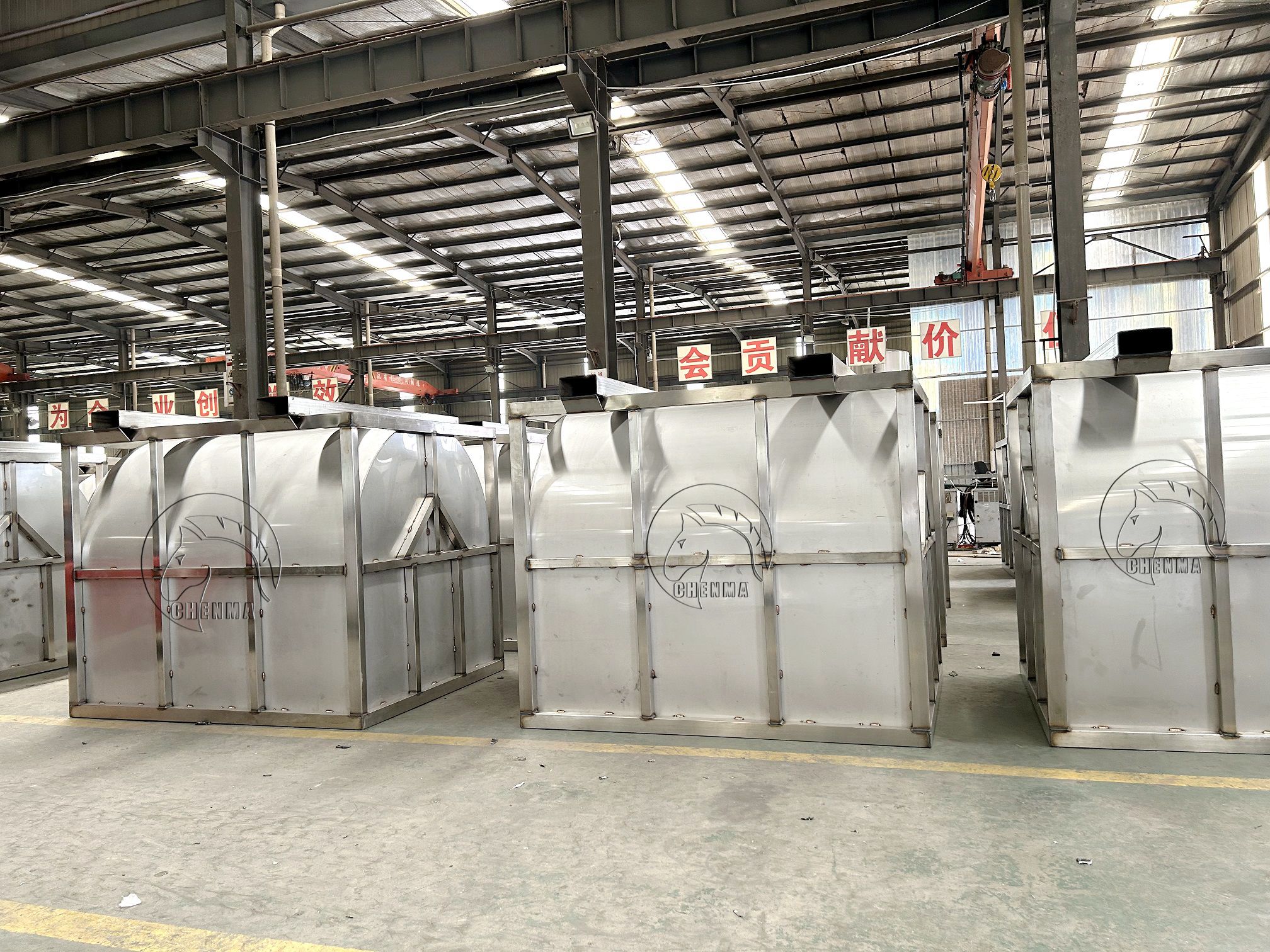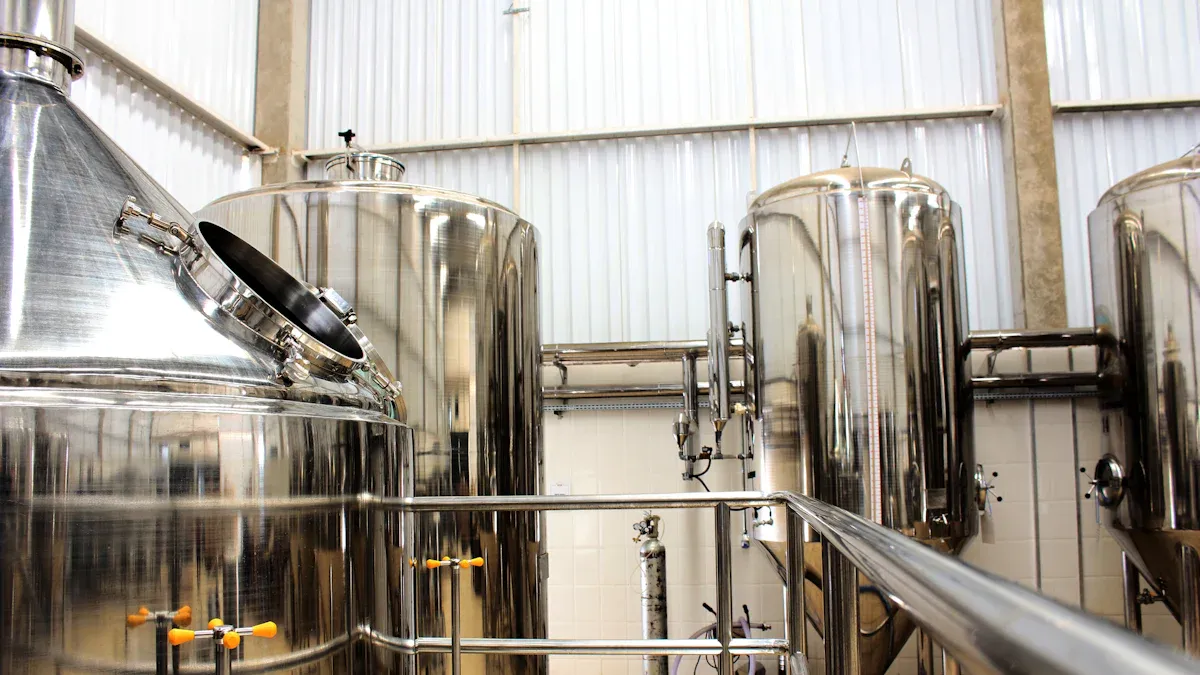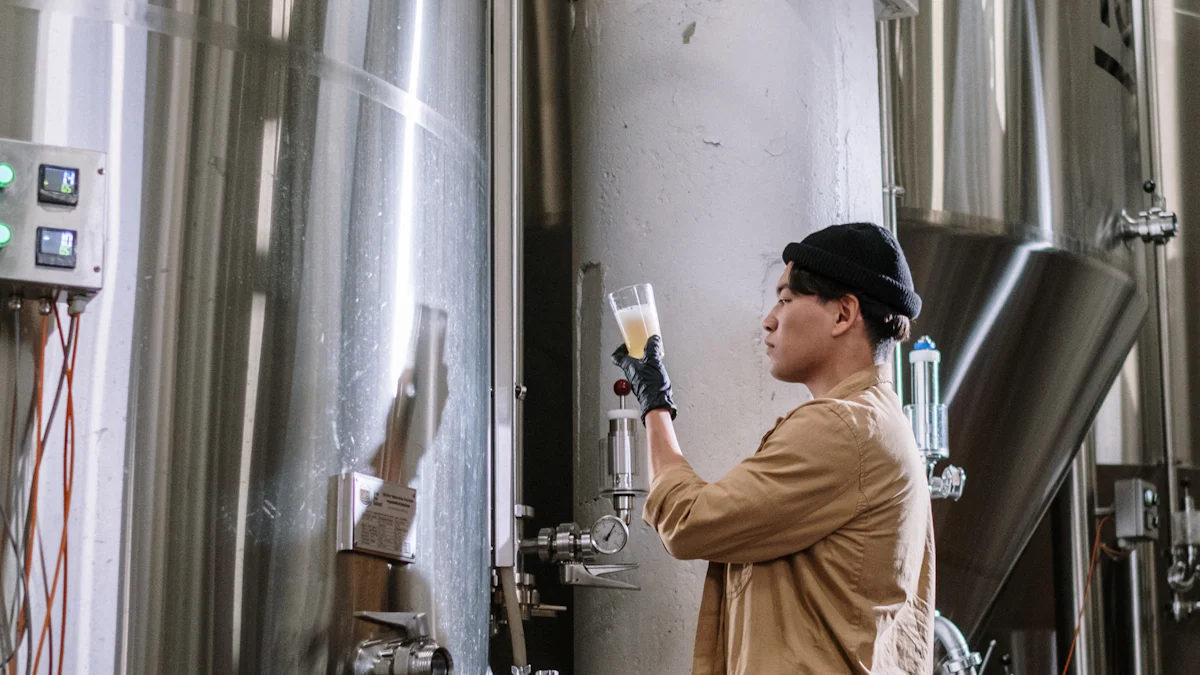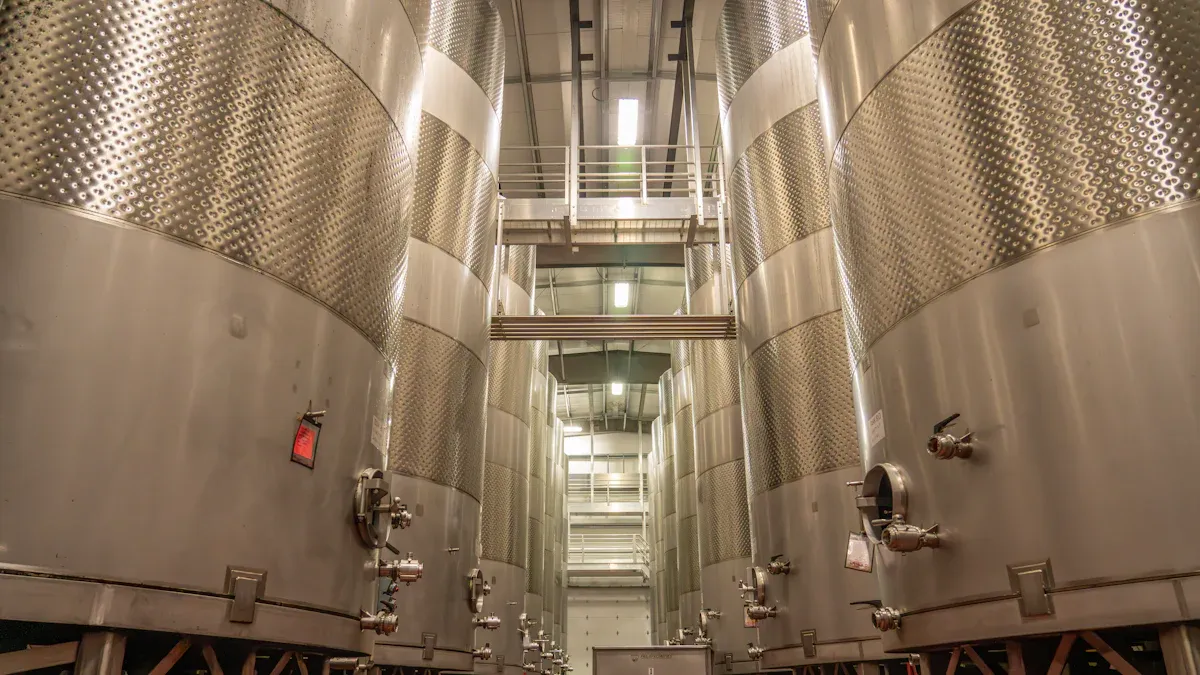
You can choose from several wine making vats in 2025, each shaping your wine in unique ways. The type of winemaking vessel you use affects the process, flavor, and style. See how different vats impact wine:
| Vat Type | Wine Quality | Efficiency | Style Influence |
|---|---|---|---|
| Wooden Vat | Boosts aroma, complexity | Moderate | Adds unique character |
| Concrete Tank | Neutral aroma, soft texture | Moderate | Preserves original style |
| Stainless Steel | Pure, aromatic wines | High | Keeps fresh, aromatic qualities |
| Oval Tank | Enhanced flavor, complexity | Moderate | Promotes lees contact, complexity |
Your vinification method and key piece of winemaking equipment matter in winemaking in vats.
Types of Wine Vats
Traditional Vats
You can find some of the oldest types of wine vats in history, such as the qvevri and amphorae. People made these vessels from clay. The qvevri has an egg shape and often sits buried underground. This design helps control temperature during fermentation. Amphorae look tall and narrow, with handles on each side. Ancient winemakers in the Mediterranean used them to store and transport wine. Clay vats allow a small amount of oxygen to reach the wine. This process creates soft textures and unique flavors. Over time, winemaking changed. The introduction of stainless steel tanks in the mid-20th century gave you more control over temperature and stopped unwanted oxidation. This shift marked a big step forward from traditional methods.
Note: Traditional vats like oak barrels and clay amphorae often add special flavors and aromas to your wine. You can taste hints of earth, spice, or even dried fruit in wines aged in these vessels.
Modern Vats
Today, you can choose from many modern types of wine vats. Stainless steel tanks lead the way in most wineries. These tanks keep your wine safe from outside air and help you control the temperature with great accuracy. You can clean them easily because they have smooth, non-porous surfaces. Modern vats also come in different shapes and sizes, letting you pick the best fit for your winemaking goals.
Here is a quick comparison of modern and traditional vats:
| Feature | Stainless Steel Tanks | Wooden Tanks |
|---|---|---|
| Durability | Highly durable, resists corrosion | Medium durability, requires more care |
| Maintenance | Easy to clean, non-porous surface | More maintenance due to porous nature |
| Cost | High initial cost | Variable cost, often lower than steel |
| Flavor Impact | Preserves natural characteristics | Adds unique flavors and complexity |
You can see that modern vats offer high durability and easy maintenance. They help you make pure, aromatic wines. Traditional vats, on the other hand, give your wine extra character and complexity. When you explore the different types of wine vats, you will notice that each option shapes your wine in a special way. Your choice of vat will affect the style, flavor, and quality of your final product.
Wine Making Vats Materials
Oak Barrels
When you use an oak barrel, you add special flavors and aromas to your wine. Oak barrels introduce notes of vanilla, clove, smoke, and coconut. You also help your wine soften because the barrel allows a small amount of oxygen to enter. This process, called micro-oxygenation, reduces harsh tannins and makes the wine smoother. Inside an oak barrel, malolactic fermentation can happen. This changes tart malic acid into softer lactic acid, giving your wine a creamy texture.
- Oak barrels add:
- Vanilla, clove, smoke, and coconut flavors
- Softer tannins and less astringency
- Creamier texture through malolactic fermentation
Stainless Steel Wine Fermentation Tanks
Stainless steel tanks have become popular for their clean and efficient design. You can control the temperature very well, which helps you make fresh and aromatic wines. These tanks do not add any flavors, so your wine keeps its pure grape taste.
| Advantages of Stainless Steel Tanks | Disadvantages of Stainless Steel Tanks |
|---|---|
| Corrosion Resistance | Lack of Flavor Complexity |
| Easy to Clean | Higher Upfront Costs |
| Excellent Temperature Control | Complex Installation |
| No Odor | |
| Lower Maintenance Costs |
Stainless steel tanks do not allow natural micro-oxygenation, so you may need other methods to add complexity.
Concrete Vats
Concrete vats help you keep a steady temperature during fermentation. The thick walls store heat and prevent big changes. The surface of concrete lets a small amount of oxygen in, which softens and stabilizes tannins. Native yeasts can live on the rough surface, helping with fermentation.
- Concrete vats:
- Keep temperature stable
- Allow gentle oxygen exposure
- Support native yeast activity
Clay and Amphorae
Clay and amphorae vats give you a natural way to make wine. Many biodynamic winemakers use them. These vats keep the wine’s flavors pure and add a rich texture. The egg shape helps the wine move naturally, mixing the lees and improving the taste. You find amphora wines in places like Georgia, Chile, Argentina, France, and South Africa.
- Clay and amphorae:
- Preserve grape flavors and aromas
- Add deep, rich texture
- Allow gentle oxygen exposure without extra flavors
Your choice of material for a wine tank shapes the style, flavor, and quality of your wine.
Wine Fermentation Tanks: Stainless Steel Focus
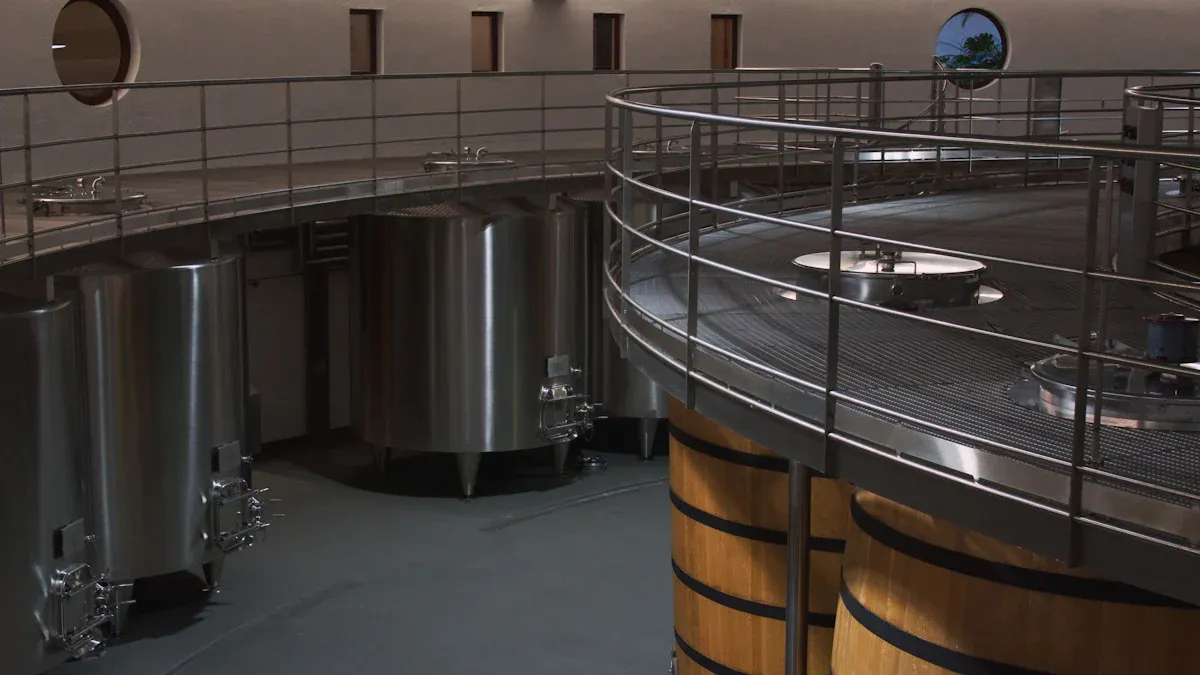
Features and Benefits
When you choose wine fermentation tanks made from stainless steel, you gain many advantages for your winery. These tanks help you control the winemaking process and protect your wine’s quality. The table below shows the main features and benefits:
| Feature/Benefit | Description |
|---|---|
| Corrosion Resistance | Stainless steel resists corrosion, so your fermenter lasts longer, even with acidic wine. |
| Temperature Control | Cooling jackets let you set and hold the perfect temperature during fermentation. |
| Easy to Clean | The smooth, non-porous surface keeps bacteria away and makes cleaning simple. |
| Durability | These tanks last for years and do not absorb flavors, so you can use them for many batches. |
| Versatility | You can use a fermenter for both fermentation and storage, and you can customize it as needed. |
| Cost-Effective | The initial cost is higher, but the long lifespan and low maintenance save you money over time. |
You can see that wine fermentation tanks made from stainless steel give you control, safety, and value. Many wineries use these tanks to make pure, aromatic wines.
Customization and Innovation
Modern wine fermentation tanks offer you advanced features that improve wine quality and efficiency. You can add automated systems to your fermenter for temperature control and fermentation monitoring. Glycol cooling systems help you keep the temperature steady, which brings out the best flavors in your wine. New tank designs help the wine develop a full flavor profile.
- You can choose tanks made with recycled materials to support sustainability.
- Custom shapes and sizes let you match your fermenter to your production needs.
- Chenma specializes in designing and building custom stainless steel vat solutions for wineries of all sizes.
When you select wine fermentation tanks, always check for certifications and quality standards. Chenma’s tanks meet ISO9001-2005 for safety and quality, and EU CE standards for environmental safety. These certifications show that your fermenter is reliable and built to last.
Vat Shapes and Designs
Oval, Cubic, and Trapezoidal
You can find wine vats in many shapes. The most common shapes are oval, cubic, and trapezoidal. Each shape changes how the wine moves inside the vat. Oval tanks create a gentle swirling motion. This movement keeps the wine in contact with the lees, which are the leftover yeast cells after fermentation. Cubic vats have straight sides and flat bottoms. These tanks make it easy to stack and save space in your winery. Trapezoidal vats have slanted sides. This design helps you drain the wine more easily and collect the solids at the bottom.
| Vat Shape | Main Feature | Benefit for Winemaking |
|---|---|---|
| Oval | Promotes vortex movement | Enhances flavor complexity |
| Cubic | Straight sides, flat bottom | Space-saving, easy stacking |
| Trapezoidal | Slanted sides | Easy draining, solid removal |
Tip: Choosing the right vat shape can help you control the wine’s contact with lees and improve the final taste.
Impact on Fermentation
The shape of your vat affects fermentation in vats in several ways. Oval tanks encourage a natural vortex. This keeps the lees moving and helps the wine develop more complex flavors. You get a richer aroma and a smoother texture. Cubic vats allow for even temperature distribution. This helps you keep the fermentation steady and avoid hot spots. Trapezoidal vats make it simple to remove solids after fermentation. This keeps your wine clear and bright. When you pick a vat shape, you shape the way your wine ferments and tastes.
Closed vs. Open Wine Making Vats
When you choose between closed and open wine making vats, you shape the way your wine develops. Each option offers unique benefits and challenges for your fermenter and the final product.
Sealed Tanks
Sealed tanks, also called closed-top fermenters, give you a controlled space for fermentation in vats. You protect your wine from outside air and unwanted microbes. This control helps you keep your wine safe and consistent. You can use advanced temperature systems with these tanks. These systems let you set the perfect temperature for yeast activity. When you use jacketed tanks, you prevent sudden temperature changes that could harm the fermentation process.
Sealed tanks help you avoid spoilage and keep your wine fresh. You get a clean, pure flavor every time.
Here is a table showing the main differences in microbial control and oxygen exposure:
| Type of Vessel | Microbial Control | Oxygen Exposure |
|---|---|---|
| Closed Fermentation | Provides a controlled environment, minimizing contamination | Minimizes oxygen exposure, reducing spoilage risk |
You can see that sealed tanks work well for most types of wine fermenters. They help you make wine that tastes the same from batch to batch.
Open Tanks
Open tanks give you a different set of tools for winemaking. You allow more oxygen into the fermenter, which can help yeast grow strong. You also make it easy to manage the cap, the layer of grape skins that forms during fermentation. This helps you extract more color and flavor.
However, open tanks come with risks. More oxygen can lead to oxidation, which causes browning and loss of freshness. You also face a higher chance of spoilage from unwanted microbes. Here is a table that shows the benefits and risks:
| Benefits of Open Fermentation | Risks of Open Fermentation |
|---|---|
| Oxygen exposure helps yeast build a strong population. | Higher risk of spoilage microorganisms due to lack of protection. |
| Heat generated during fermentation can escape easily. | Excess oxygen can lead to oxidation. |
| Allows better access to the cap for flavor extraction. | Carbon dioxide production may fall, increasing vulnerability. |
You should use open tanks for certain types of wine fermenters, like those that need more flavor extraction. Always watch for signs of spoilage and control oxygen exposure to protect your wine.
Pros and Cons of Vat Types
Traditional Vats
When you use traditional vats, you connect with winemaking methods that go back thousands of years. Clay amphorae and oak barrels have shaped wine styles since ancient times. For example, winemakers in Georgia have used qvevri for over 8,000 years. Oak barrels add flavors like vanilla and spice, which many people enjoy. These vats allow small amounts of oxygen to reach the wine. This process softens tannins and creates a smooth texture.
Pros:
- Add unique flavors and aromas to your wine
- Support natural fermentation with native yeasts
- Help soften tannins for a smoother mouthfeel
Cons:
- Require more maintenance and cleaning
- Can be expensive to replace or repair
- Offer less control over temperature during fermentation
Note: Traditional vats often work best for small-batch or artisanal wines where character and complexity matter most.
Modern Vats
Modern vats, such as stainless steel tanks, have changed the wine industry. Today, over 90% of large wineries use stainless steel tanks for fermentation. These tanks give you precise temperature control, which helps you make consistent wine every year. Stainless steel does not add any flavors, so your wine keeps its original taste. You can clean these tanks quickly, which reduces the risk of spoilage.
Pros:
- Provide excellent temperature control for fermentation
- Easy to clean and maintain
- Allow for large-scale production and consistency
Cons:
- Do not add extra flavors or aromas to the wine
- High initial investment for equipment
A modern vat helps you produce fresh, aromatic wines with reliable results. Many wineries choose these tanks for their efficiency and safety.
Influence on Wine Quality and Style
Flavor and Aroma
When you select a wine making vat, you shape the flavor and aroma of your wine. The material and design of the vat affect how your wine smells and tastes. Some vats add flavors, while others keep the grape’s natural character.
You can see how different vats change the concentration of volatile organic compounds (VOCs), which are important for aroma and taste. Scientific studies measured these changes:
| Vat Type | VOC Concentration Change | Statistical Significance |
|---|---|---|
| Plastic Vats | Highest increase | p < 0.05 |
| Concrete Vats | Moderate increase | Not specified |
| Stainless Steel | Moderate increase | Not specified |
| Oak Barrels | Decrease | p > 0.05 |
Plastic vats show the highest increase in VOCs, which means stronger aromas. Concrete and stainless steel vats also increase VOCs, but not as much. Oak barrels actually decrease VOCs, but they add their own flavors like vanilla and spice. You might notice that wines from oak barrels have a softer, rounder taste, while wines from stainless steel tanks taste fresher and more pure.
Tip: If you want to highlight the grape’s natural aroma, choose stainless steel or concrete vats. If you prefer extra flavors, oak barrels work best.
Aging and Texture
The process of maturation in wine making vats changes the texture and mouthfeel of your wine. The choice of vat material and design controls how your wine ages and develops.
You can compare the benefits of different vat materials for maturation:
| Benefit | Description |
|---|---|
| Temperature Stability | Thick concrete walls provide excellent insulation. |
| Micro-Oxygenation | Subtle oxygen exchange helps soften tannins. |
| Neutral Flavor Impact | Does not impart flavors, allowing grape character to shine. |
Concrete vats offer stable temperatures during maturation. This stability helps your wine age slowly and evenly. Micro-oxygenation, which happens in semi-porous vats like concrete, lets a small amount of oxygen enter. This softens tannins and improves mouthfeel. Stainless steel tanks do not allow oxygen in, so your wine stays crisp and bright. Oak barrels allow more oxygen, which speeds up maturation and adds smoothness.
You can see how these factors affect aging in vat:
| Factor | Impact on Wine Aging and Texture |
|---|---|
| Temperature Stability | Maintains stable temperature, reducing fluctuations during aging. |
| Micro-Oxygenation | Allows subtle oxygen exchange, softening tannins and improving mouthfeel. |
| Neutral Flavor Impact | Does not impart flavors, preserving the grape’s true characteristics. |
If you want a wine with a pure grape taste and a firm texture, use stainless steel vats for maturation. If you want a softer, rounder wine, choose concrete or oak barrels. The process of winemaking in different vats lets you control how your wine feels and tastes as it matures.
Note: The right vat can help you create a wine that matches your vision, whether you want bold flavors or a delicate, smooth finish.
Maturation in vats shapes every part of your wine. You guide the process by choosing the right vessel. The texture, aroma, and flavor all depend on your decisions during maturation. When you understand how vat materials and designs work, you can make wines that stand out.
Choosing the Right Wine Vat
Production Scale
When you select a wine making vat, you need to match it to your production scale. Small wineries often use traditional vats or a single fermenter for each batch. Larger wineries invest in advanced fermenter systems to handle bigger volumes. The size of your operation affects your costs and equipment choices.
Here is a table that shows the main cost factors for wineries:
| Factor | Description |
|---|---|
| Grape Cost | Represents a significant portion of production expenses, often up to 60%. |
| Land Cost | Affects overall costs and pricing based on location and mortgage payments. |
| Labor Cost | Includes costs associated with hiring skilled personnel for production. |
| Equipment Cost | Investment in machinery can impact production efficiency and quality. |
| Packaging Cost | Costs related to bottling and labeling the wine. |
| Storing Cost | Expenses incurred for storage facilities and conditions. |
| Marketing Cost | Costs associated with promoting and selling the wine. |
Larger wineries can invest in new technology and hire skilled workers. They often increase the size of their company and machinery. You can focus on reducing variable costs while increasing fixed costs. When you scale up, you can justify premium pricing and improve quality control.
Wine Style Goals
Your wine style goals guide your choice of fermenter. If you want fresh, aromatic wines, you might choose a stainless steel fermenter. For wines with more complexity, you may select an oak or concrete fermenter. The process you use in the fermenter shapes the final taste and texture.
You can use these steps to match your vat to your style goals:
- Decide if you want to highlight pure fruit flavors or add complexity.
- Choose a fermenter that supports your desired aging and texture.
- Adjust your process to fit the vat and grape variety.
Tip: The right fermenter helps you create wines that stand out in the market.
Future Trends in Wine Making Vats

Smart Vats
You will see rapid changes in how wineries use technology in 2025. Many producers now use smart fermenter systems to improve wine quality and efficiency. These systems use advanced sensors and IoT-enabled tanks. You can monitor temperature, pH, and other key factors in real time. This helps you make quick adjustments and reduce mistakes. Automation and Industry 4.0 tools are changing the way you manage your fermenter. Wineries invest more in smart systems to keep up with premium wine demand. The table below shows the latest advancements:
| Advancement Type | Description |
|---|---|
| Advanced Sensor Technologies | Real-time adjustments in winemaking through data analytics, improving quality and reducing waste. |
| IoT-Enabled Fermentation Tanks | Monitor temperature and pH in real time, minimizing human error and improving consistency. |
| Automation and Industry 4.0 | Transforming wine production machinery, leading to more investment in smart systems. |
| Sustainable Practices | Automated and sustainable machinery supports premium wine production. |
You can use these smart fermenter systems to make better wine with less waste.
Sustainability
Sustainability shapes the future of wine making vats. You will notice that consumers want eco-friendly wines. Producers respond by using fermenter designs that save energy and water. Many wineries choose tanks made from recycled materials. You can see these trends in the market:
- Consumers want premium, health-conscious, and sustainable wines.
- Digital engagement changes how you discover and buy wine, so brands innovate.
- Health trends push for low-alcohol and organic wines, so producers adapt their fermenter technology.
- Sustainability matters more, so companies use eco-friendly tanks and processes.
- Unique and experiential products drive innovation in wine making vats.
- E-commerce growth means producers improve their digital presence and technology.
- Environmental responsibility becomes a top priority for many wineries.
You can expect more wineries to use smart fermenter systems and sustainable tanks as these trends continue.
You shape your wine by choosing the right vat. See the main differences and impacts below:
| Vat Type | Key Feature | Wine Impact |
|---|---|---|
| Wooden | Oxygen exchange | Boosts aroma, softens tannins |
| Concrete | Micro-oxygenation | Pure flavors, stable fermentation |
| Stainless Steel | Airtight, neutral | Preserves grape’s true taste |
Pick stainless steel for durability and easy cleaning. Choose oak for added flavors. Watch for new smart vats and eco-friendly designs in the future.
FAQ
What is the most popular wine vat material in 2025?
Stainless steel leads the market. Over 90% of large wineries use stainless steel tanks for fermentation because they offer precise temperature control and easy cleaning.
How does vat shape affect wine quality?
Oval vats create a natural vortex. This movement increases lees contact and boosts flavor complexity. Studies show wines from oval vats often have richer aromas and smoother textures.
Can you reuse wine vats?
Yes, you can reuse stainless steel vats for decades. Oak barrels last 3–5 years for flavor impact. Concrete and clay vats can last over 50 years with proper care.

